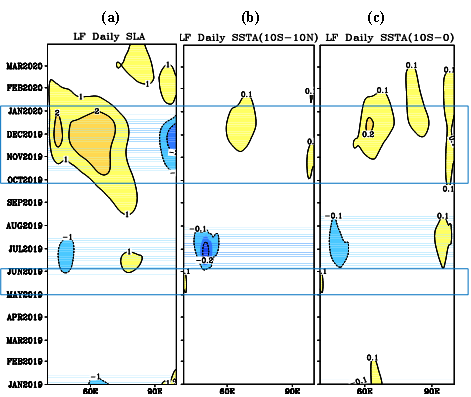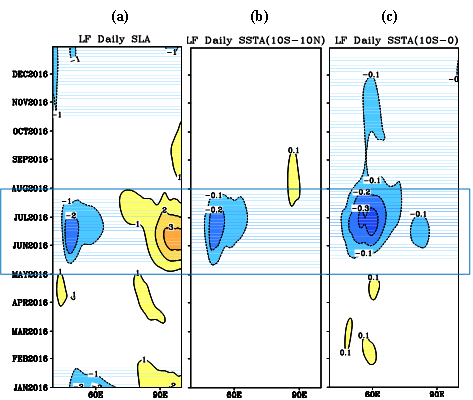季节内风场对近期印度洋偶极子事件的调制
季节内风场对近期印度洋偶极子事件的调制
太平洋和印度洋年际气候异常事件造成全球气候异常,目前对其产生的最主要的假设之一是所谓的“季节内调制效应”,即热带印太经常发生的季节内振荡,如MJO等,通过海洋非线性产生初始的年际异常,再通过海气耦合正反馈机制放大,形成ENSO和印度洋偶极子(IOD)事件的爆发。ENSO现象发生在太平洋,而IOD发生在相邻的印度洋,两者有着紧密的联系,但是又有一定的独立性。2019和2016年发生了极端的正、负IOD事件,但热带太平洋却处于中性状态或者弱La Niña状态。这类极端IOD事件爆发背后的动力学机制仍不清楚。热带印度洋风场包含强烈的季节内变化。一些研究推测, 2016年和2019年的极端IOD事件是由MJO激发的。Zhao and Yuan (2021) 利用海洋环流模式实验,评估了1996-2020年季节内风场通过海洋非线性对IOD事件年际变化的调制影响。结果表明,调制的年际海表温度异常(SSTA)和海平面高度异常比观测年际异常小很多,表明IOD主要由低频风强迫。论文已经被国际气候学研究的权威学术期刊Climate Dynamics接受发表,预发表稿已经上线(https://link.springer.com/article/10.1007/s00382-021-05943-1)。
这项研究结果,结合我们前期关于太平洋季节内风场通过海洋非线性对年际信号只有极弱调制效应的论文研究(Zhao et al. 2019),显示ENSO和IOD等极端年际气候异常事件,不大可能是由大气季节内振荡诱发。而西边界非线性反射和印尼贯穿流的“海洋通道”作用,可能是值得进一步探究的重要动力过程。以上两篇论文,对ENSO等极端年际异常事件的爆发机制,提出了颠覆性挑战,是重要的原创性研究成果。
研究表明,尽管2019年秋冬季热带印度洋发生了强烈的季节内东风事件,但其调制的年际SSTA在2019年正IOD事件的成熟和终止阶段只起次要作用(图1)。2016年5月至7月中旬发生了一系列季节内西风事件,但其直接调制的SSTA在东南印度洋很弱(图2)。另外,季节内变化必须通过非线性过程才能产生年际变异。我们在热带印度洋东边界附近发现了一种新的季节内非线性调制机制,即海洋赤道波在东边界的反射导致纬向流减速,从而通过纬向非线性平流在2016年春夏季调制产生低频的下降开尔文波。然而,由东边界反射引起的调制异常远小于总的年际异常,表明季节内风场调制对IOD的影响不显著。
Evaluation of intraseasonal wind rectification on recent Indian Ocean dipole events using LICOM
Xia Zhao and Dongliang Yuan
The Effects of intraseasonal wind rectification on the interannual variability in Indian Ocean Dipole (IOD) events during 1996-2020 are estimated using an ocean general circulation model forced with daily wind stress. The results of the experiments with and without the intraseasonal winds suggest that rectified interannual sea surface temperature anomalies (SSTAs) and sea level anomalies (SLAs) are much smaller than those observed and simulated total interannual anomalies, suggesting that IOD are forced primarily by low-frequency winds. The rectified interannual SSTAs play a secondary role in the mature and terminating phases of the 2019 positive IOD event, despite the strong intraseasonal easterly wind events during the fall-winter of 2019. From May to mid-July 2016, a series of intraseasonal westerly wind events rectify the negative interannual SSTAs in the tropical western Indian Ocean, which reinforce the onset of the 2016 negative event through ocean-atmosphere coupling, but with little SSTA generated in the southeastern Indian Ocean directly. Analyses demonstrate that intraseasonal rectification is induced primarily through nonlinear zonal and vertical advection in the 2016 and 2019 extreme IOD events. A new type of intraseasonal rectification dynamics is identified near the eastern boundary owing to the reflection of oceanic equatorial waves at the eastern boundary resulting in the deceleration of zonal currents, which rectifies low-frequency downwelling Kelvin waves through the zonal advection term during the spring-summer of 2016. However, the rectified anomalies due to the eastern boundary reflection are much smaller than the total interannual anomalies, suggesting nonsignificant effects of the intraseasonal winds on IOD.
Zhao Xia, Dongliang Yuan, (2021). Evaluation of intraseasonal wind rectiication on recent Indian Ocean dipole events using LICOM, Climate Dynamics, https://link.springer.com/article/10.1007/s00382-021-05943-1.

图1. 2019年正IOD,季节内风场变化调制的低频SLA 和SSTA。

图2. 2016年负IOD,季节内风场变化调制的低频SLA 和SSTA。


